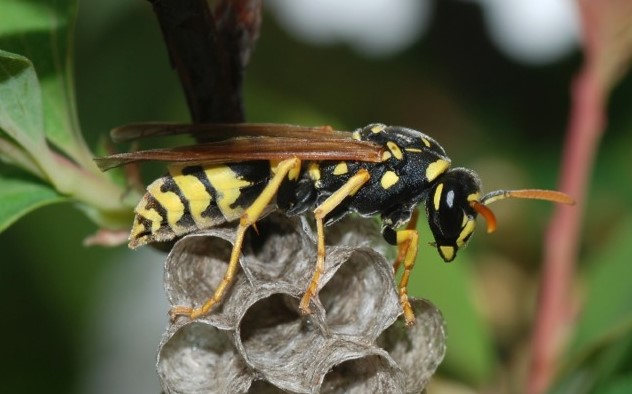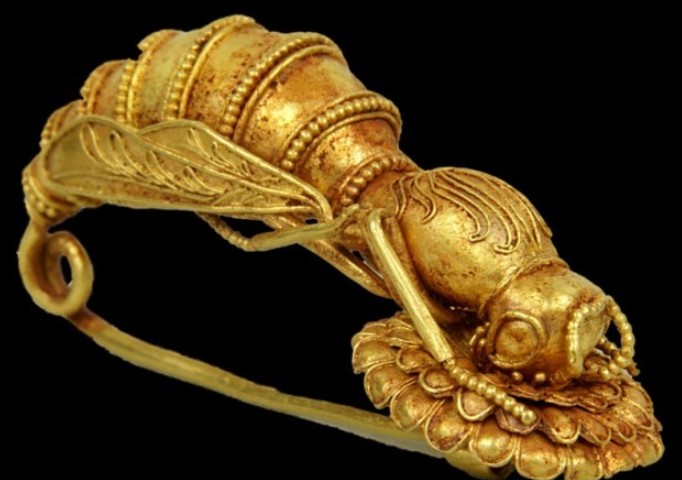Bees: Legends and Myths : If you turn to ancient legends, myths, traditions, and religions, you will notice that the bee is the most popular and mysterious creature. The most ancient and unusually vivid legend associated with bees can be found in the Old Slavonic Vedic culture. According to their legends, the first scouts on Earth sent by the Creators were seven Amazons. They flew to Earth conceived, and each of them held plant seeds in one hand, and bees in the other.
The Amazons were to give birth to the Titans on Earth, which were to turn the dusty Earth into a plantation blooming with billions of planets. The bees gave the Amazons everything they needed – food, warmth, connection with their home – the heavenly system. Billions of plants planted on the Earth prepared for life provided food for bees, served as the starting material for the production of wax, honey, and nectar. Wax – as a reserve of fuel for the photon engines of intergalactic rockets, was stored in the bowels of the Earth. To match the Titans – everything was then huge in size and bees and plants. A series of floods changed the life of the Earth and its humanoid inhabitants, but since then the most cosmic creatures – bees – have always remained unchanged earthlings. And the reserves of wax are still kept by the Earth in its womb.
In pre-Christian times, many familiar words today associated with the theme of bees sounded differently. So, bees were called wasps; beehive – with a deck; a swarm of bees – with a cord; the beekeeper is a sorcerer; the hive’s entrance is an eye, a wax candle is an idol. The expression “The sorcerer conjures over the deck” – meant that the beekeeper was reading the dance of the bees.
Absolutely everything in Vedic culture that was associated with the gods was also associated with bees. Wasps (bees) were considered a link between the Worlds of people and gods. Wasps (bees) – as carriers of divine information, were asked for any advice and any questions. Answers and messages from the gods came through the bees. Sorcerers (beekeepers) were able to see runic pictures in the dance of bees – messages or answers of the gods. The first letters or runes of the Old Church Slavonic alphabet carry the following information: AZ – the basis, essence, meaning, wasp (bee); BUKI – letter, rune, image, language; LEAD – to know, know, understand, read. Combining AZ, BUKI, and VEDI we get the phrase “I understand the meaning of images” or in other words “I know the language of the wasps”.
Since ancient times, man has been associated with bees. Getting honey was one of his means of subsistence. Echoes of this have come down to us in myths and legends, as well as in the form of images of bees on bowls, vessels, coins, etc. All peoples of antiquity worshiped one or another animal. Among them, bees occupied a special place.
In ancient Egypt, the bee was revered and depicted on obelisks. Pharaoh Minos, who united Lower and Upper Egypt, chose the bee as the emblem of Lower Egypt. The Egyptians painted a bee on their petitions to the Pharaoh as a symbol of devotion. They saw in bees an example of selflessness, fearlessness, contempt for death, danger, as well as the guardians of ideal purity and order. Egyptian pharaohs held the title of Lord of the Bees. According to the beliefs of the Egyptians, the soul, leaving the body, turns into a bee. Therefore, images of bees are found on the tombs of the first dynasty of the pharaohs, and vessels with honey are found in their tombs. Images of hives have also been found on the graves of other Egyptians.
In India, the land of the most ancient culture, we find a lot of evidence of interest in bees. The Indian name for the bee is “Madhukar”, which means “making honey.” She is mentioned in myths, songs. The Indian sun god Vishnu is depicted as a small bee resting in a bowl of a lotus flower, it is said about him that where his footsteps … honey will flow. God Krishna was portrayed with a blue bee flying overhead.
In the language of some African tribes, the plurality of objects is emphasized by comparison with bees. In order to say that a person has a lot of livestock, they say: “His livestock is like bees in a swarm” or “the number of his cows is like a honeycomb.”
Some peoples of the Middle East have the custom of installing hives on the graves of people who were distinguished by courage during their lifetime. There are several explanations for this. It is believed that bees will guard the grave as carefully as they guarded their combs, or that a swarm of bees provides the deceased with the food necessary to travel to the next world. Most often, bees were believed to symbolize immortality.
Like the spirits or the wind that change their place but never die, their image on the graves will live on in the instructions they gave during life. Many peoples have firmly adhered to the custom of informing the inhabitants of the hive that someone in the host family has died. It was considered obligatory to address the bees in the most friendly way, not skimping on affectionate words, as they may take offense and leave the hive.
The Arabic name for the bee “nekhlet” means “gift of God”. According to Persian legends, bees sit on the lips of the deity of truth and faith – Minas, and he immediately recognizes the liar, punishing him with a sting.
Ancient Greek mythology is rich and varied. In it, along with the gods, bees are often mentioned. It is known that ambrosia served as food for the immortal Olympian gods, and nectar as a drink. “Divine nectar” can undoubtedly be identified with flower nectar and ambrosia with flower pollen. During feasts on Olympus, a beautiful couple scurries around the feasting: the goddess of youth Hebe and the young man Ganymede. They carry ragweed with an amazing sweetness that melts in your mouth. It gives the whole body strength, peace of mind, immortality of the soul. Nectar is served in golden cups. The Lydian king Tantalus, the son of Zeus, visited Olympus more than once by the will of the gods, feasting with them at the same table. And Tantalus became proud, began to consider himself equal to them. Returning from Olympus, he took with him the food of the gods – ambrosia and nectar – and treated them to his friends, feasting in his palace. For this, the gods severely punished him.
Bees in the concept of ancient peoples have always referred to the attributes of the divine. So, the emblems of Zeus were the eagle and the bee. Greek mythology tells that Zeus, who was born in Crete and raised in a cave, was fed with the milk of a divine goat and nectar. The golden cradle of Zeus stood in the Idaisky grotto. All nature surrounded the cradle of the new god with love. Doves from the shores of the ocean brought him ambrosia, an eagle flew in every evening, carrying a cup of nectar in its claws, the bees collected the sweetest honey for him and guarded the entrance to the cave. When mortals entered Zeus’ cave to steal honey, they were attacked by bees.
According to mythology, beekeeping in Greece is closely related to the name of Aristeus. On a beautiful sunny day, Apollo met a girl of rare beauty, Cyrene, whom he fell in love with and made his wife. They named their son Aristeas. According to tradition, Apollo gives the newborn to nymphs to raise. They taught Aristeus the art of cultivating the land and, mainly, beekeeping. As an adult, Aristeus wanted to share his acquired knowledge with people. To this end, he visits the island of Kea in the Aegean Sea, where he teaches local residents about beekeeping. Later, in honor of the memory of Aristeus, the inhabitants of Kei minted a coin with his image.
Roman poet Ovid writes about this: “Once Bacchus, accompanied by satyrs, was walking in the Rhodope valley covered with flowers, when unknown insects began to flock to the sound made by the satyr cymbals – they were bees. Bees flew to the sound of copper, and Bacchus, having gathered them in a swarm, locked them in a hollow. ”
According to French and Swiss folk beliefs, bees are the souls of the dead. Noble persons adorned their coat of arms with the image of a bee, symbolizing diligence and order.
The northern epic connects the myth of the origin of the sacred honey, which gives strength, poetic inspiration, and wisdom.
The ancient Vikings, who went into battle, believed that in Valhalla (the abode of Einherie – brave warriors who died in battle), inexhaustible honey milk of the goat Heidrun awaits them, and the sagas say that at the table of the father of heroes – Wotan – the elect will receive from the hands of the Valkyries horn with marvelous honey.
In America, the Maya tribe had the bee god Ahmuzenkab, whose images are found on the wall decorations of architectural monuments. The Maya Indians also worshiped other gods, who were considered the patrons of bees. They took every precaution so as not to harm the bees when working with them, and if a bee died, they even wrapped it in a leaf and buried it. Candles were prepared from wax, which was used as an offering to the gods. In the proverb of the Latin American peoples, it is said that the bee was created by angels. According to legend, the great spirit of Manitou created bees from the people of the Indian tribe, who were distinguished by great diligence, and turned lazy into flies.
A number of Australian tribes associate beekeeping with the name Bayamo. Once, in search of wild honey, he followed a bee, to whose leg he tied a bird’s feather.
The bee was called God’s saint, God’s wisdom, and endowed with holiness. It was believed that she only stings the sinner. Lightning never strikes a hive with bees. Bees, unlike bumblebees, hornets, or wasps, which the devil created, owe their origin to God. Bees are found only among good people, and they do not like evil ones. They unite people, bind them with spiritual kinship.
Belarusians believed that bees bring kind people closer together. Common bees from two different owners connect them with brotherly bonds, and they become friends who help each other in everything. Such bees swarm well, produce a lot of honey and wax. Fraternal relations between the owners of bees arise when a swarm of one of them descends into the hive of another or when at a wedding the newlyweds are given half of their bees. Spiritual kinship based on joint ownership of bees is sacred, given by God himself.
Folk tradition endows the bee not only with purity and holiness but also celibacy. In conspiracies, she is called the bee-maiden. According to legend, the tears of a beautiful maiden who sat on a stone in the middle of the sea turned into bees.
In Serbian beliefs, God commanded bees to reproduce without mating: the queen bee simply lays eggs, and bees are born from them. There is a well-known Serbian legend about the origin of bees from the tears of a mother, who mourned her ruined and then resurrected son. In it, the image of the mother coincides with the image of the Mother of God. The similarity of the queen bee with the Mother of God is manifested in their names: queen and Mother. And the tsarist symbolism makes her in common with the Heavenly Queen: in Ukrainian prayer, the “queen-queen” is addressed to the queen bee, and in the Russian legend God turns horned people who once lived on earth into a queen bee. In conspiracies, the queen bee is called, like the Mother of God, Mary. The Mother of God is considered the patroness of bees and their owners, at the Assumption of the Virgin, so that the bees have good offspring, they are treated to consecrated honey in the church.
There is a well-known Serbian legend about the origin of bees from the tears of a mother, who mourned her ruined and then resurrected son. In it, the image of the mother coincides with the image of the Mother of God. The similarity of the queen bee with the Mother of God is manifested in their names: queen and Mother. And the tsarist symbolism makes her in common with the Heavenly Queen: in Ukrainian prayer, the “queen-queen” is addressed to the queen bee, and in the Russian legend God turns horned people who once lived on earth into a queen bee. In conspiracies, the queen bee is called, like the Mother of God, Mary. The Mother of God is considered the patroness of bees and their owners, at the Assumption of the Virgin, so that the bees have good offspring, they are treated to consecrated honey in the church.































